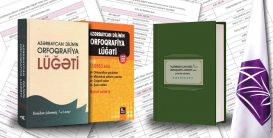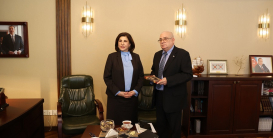Medieval medicine in Azerbaijan: forms of treatment that were ahead of time for centuries.

Unfortunately, today the Islamic world and the science that it possesses is not so strong as before. The Muslim East in the Middle Ages was considered the renaissance centre of science and culture throughout the world. All aspects of sciences reached their peak of development in the Arab world, Iran, Turan and Azerbaijan. People who were carriers of encyclopaedic intellect on all sciences were titled as philosophers. Their research objects were both the secular and religious sciences.
There is good reason to start with Ibn Sina, the founder of contemporary medical science. Abu Ali Ibn Sina (970-1037) was a popular scientist in medicine in the whole East and in Azerbaijan as well. One of the oldest copies of his book - 'The Canon of Medicine' - a medical encyclopaedia is kept at the Institute of Manuscripts of Azerbaijan National Academy of Sciences.
After Ibn Sina there happened a real revolution in medicine in the whole East. Very soon, it gave strong rise to bringing up professional physicians and establishing treatment centres in Azerbaijan. Ibn Jassar, a Muslim scientist, discovered leprosy and the forms of its treatment. Ibn Namig discovered the forms of treatment for cholera, called the Black Death, and saved thousands of people's lives. Kambur Vasim, a doctor, discovered the tubercule bacillus and the ways of wiping them out. Ibn Ammar who did the first eye surgery and made a revolution in ophthalmology. Ali Ibn Abbas conducted a malignant tumour operation and brought people back to life. Later, the following scientists' discovery raised the medicine to the top of other sciences in Muslim world: Ibn Nasif discovered the lesser circulation process, Ali Ibn Ridvan established the first hospital, and Ibn Baytar wrote the first book on pharmacology. Along with the above mentioned facts, the establishment of the first chemical lab by Jabir Shafi, the discovery of medical alcohol by Fakhraddin Razi, the microbe theory founded by Agh Shamsaddin affected Azerbaijan. The developing cities from economic and cultural aspects constantly followed the novelties that had happened in scientific centres of the East - in Baghdad, Nishapur and Sham.
In the XIII-XIV centuries only in Azerbaijan 67 hospitals functioned. Professionals in medicine and pharmacology worked in those hospitals. In the XIV century, a scientific centre 'Darush-shifa' was founded in Tabriz. In fact, it was a full scientific centre with educational, health and scientific institutions, including an observatory. Along with Azerbaijani scientists and scholars, professionals who had been invited from China, India, Syria and Egypt were also working for the centre.
Naturally, the main attention was paid to medicine there. There were 67 health houses at the Academy then. The first treatment institution was called 'Rashidiyya'. Fifty doctors and five assistants for each of them worked at that health institution. Professional specialists, including dentists were working for that institution. There were several chemists shops there. The doctors working for the institution were provided with accommodation.
In the XV century, Sultan Yagub, Azerbaijani ruler constructed 'Yeddi Jannat' ('Seven Paradise') Palace in Tabriz. There was a hospital with 1000 beds and a chemists shop with medicines brought from the four corners of the earth, including India and China. Experienced doctors worked for that hospital.
Elmin NURİ
AND OTHER...
-
 Movlud Movlud’s Short Story on Turkish Portals
Movlud Movlud’s Short Story on Turkish Portals
“Detayhaberler.com”, “Dibace.net” and “Haber.232.com”, leading Turkish portals, have posted in Turkish the short story “We Have Already Grown Up” by the...
-
 The Book “The Classification of Words Extracted from “The Spelling Dictionary of the Azerbaijani Language” Out
The Book “The Classification of Words Extracted from “The Spelling Dictionary of the Azerbaijani Language” Out
The Azerbaijan State Translation Centre has published a voluminous book “The Classification of Words Extracted from “The Spelling Dictionary of the Azerbaijani Language”
-
 Ambassador Carlos Enrique Valdes de la Concepcion: A New Stage in Azerbaijani-Cuban Literary Relations Begins
Ambassador Carlos Enrique Valdes de la Concepcion: A New Stage in Azerbaijani-Cuban Literary Relations Begins
On April 03, 2024, the Ambassador Extraordinary and Plenipotentiary of the Republic of Cuba to Azerbaijan, Carlos Enrique Valdes de la Concepcion, visited the State Translation Centre.









